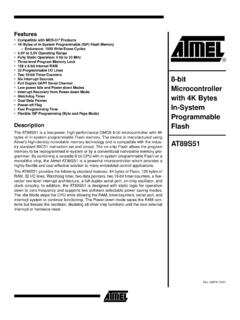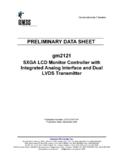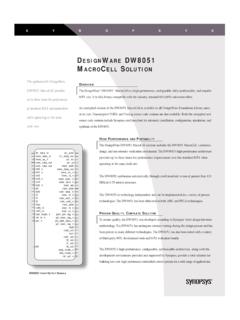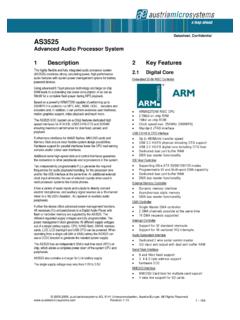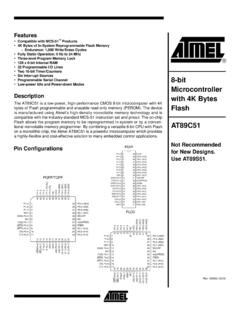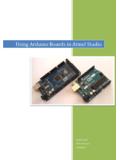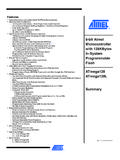Transcription of 2K Bytes of Reprogrammable Flash Memory …
1 1 Pin ConfigurationPDIP/SOIC123456789102019181 7161514131211 RST/VPP(RXD) (TXD) (INT0) (INT1) (TO) (T1) (AIN1) (AIN0) Compatible with MCS-51 Products 2K Bytes of Reprogrammable Flash Memory Endurance: 1,000 Write/Erase Cycles to 6V Operating Range Fully Static Operation: 0 Hz to 24 MHz Two-level Program Memory Lock 128 x 8-bit Internal RAM 15 Programmable I/O Lines Two 16-bit Timer/Counters Six Interrupt Sources Programmable Serial UART Channel Direct LED Drive Outputs On-chip Analog Comparator Low-power Idle and Power-down ModesDescriptionThe AT89C2051 is a low-voltage, high-performance CMOS 8-bit microcomputer with2K Bytes of Flash programmable and erasable read only Memory (PEROM). Thedevice is manufactured using Atmel s high-density nonvolatile Memory technologyand is compatible with the industry-standard MCS-51 instruction set. By combining aversatile 8-bit CPU with Flash on a monolithic chip, the Atmel AT89C2051 is a power-ful microcomputer which provides a highly-flexible and cost-effective solution to manyembedded control AT89C2051 provides the following standard features: 2K Bytes of Flash , 128bytes of RAM, 15 I/O lines, two 16-bit timer/counters, a five vector two-level interruptarchitecture, a full duplex serial port, a precision analog comparator, on-chip oscillatorand clock circuitry.
2 In addition, the AT89C2051 is designed with static logic for opera-tion down to zero frequency and supports two software selectable power savingmodes. The Idle Mode stops the CPU while allowing the RAM, timer/counters, serialport and interrupt system to continue functioning. The power-down mode saves theRAM contents but freezes the oscillator disabling all other chip functions until the nexthardware 0368E 02/008-bit Microcontroller with 2K Bytes FlashAT89C2051AT89C20512 Block DiagramAT89C20513 Pin DescriptionVCCS upply 1 Port 1 is an 8-bit bi-irectional I/O port. Port pins provide internal pullups. and require exter-nal pullups. and also serve as the positive input(AIN0) and the negative input (AIN1), respectively, of theon-chip precision analog comparator. The Port 1 outputbuffers can sink 20 mA and can drive LED displays 1s are written to Port 1 pins, they can be used asinputs. When pins to are used as inputs and areexternally pulled low, they will source current (IIL) becauseof the internal 1 also receives code data during Flash programmingand verification.
3 Port 3 Port 3 pins to , are seven bi-irectional I/Opins with internal pullups. is hard-wired as an input tothe output of the on-chip comparator and is not accessibleas a general purpose I/O pin. The Port 3 output buffers cansink 20 mA. When 1s are written to Port 3 pins they arepulled high by the internal pullups and can be used asinputs. As inputs, Port 3 pins that are externally beingpulled low will source current (IIL) because of the 3 also serves the functions of various special featuresof the AT89C2051 as listed below:Port 3 also receives some control signals for Flash pro-gramming and verification. RSTR eset input. All I/O pins are reset to 1s as soon as RSTgoes high. Holding the RST pin high for two machinecycles while the oscillator is running resets the device. Each machine cycle takes 12 oscillator or clock to the inverting oscillator amplifier and input to theinternal clock operating circuit.
4 XTAL2 Output from the inverting oscillator Characteristics XTAL1 and XTAL2 are the input and output, respectively,of an inverting amplifier which can be configured for use asan on-chip oscillator, as shown in Figure 1. Either a quartzcrystal or ceramic resonator may be used. To drive thedevice from an external clock source, XTAL2 should be leftunconnected while XTAL1 is driven as shown in Figure are no requirements on the duty cycle of the externalclock signal, since the input to the internal clocking circuitryis through a divide-by-two flip-flop, but minimum and maxi-mum voltage high and low time specifications must 1. Oscillator ConnectionsNote:C1, C2 = 30 pF 10 pF for Crystals= 40 pF 10 pF for Ceramic ResonatorsFigure 2. External Clock Drive ConfigurationPort PinAlternate (serial input port) (serial output port) (external interrupt 0) (external interrupt 1) (timer 0 external input) (timer 1 external input)AT89C20514 Special Function RegistersA map of the on-chip Memory area called the Special Func-tion Register (SFR) space is shown in the table that not all of the addresses are occupied, and unoc-cupied addresses may not be implemented on the accesses to these addresses will in general returnrandom data, and write accesses will have an indetermi-nate software should not write 1s to these unlisted loca-tions, since they may be used in future products to invokenew features.
5 In that case, the reset or inactive values ofthe new bits will always be 1. AT89C2051 SFR Map and Reset Values0F8H0 FFH0F0HB000000000F7H0E8H0 EFH0E0 HACC000000000E7H0D8H0 DFH0D0 HPSW000000000D7H0C8H0 CFH0C0H0C7H0B8 HIPXXX000000 BFH0B0HP3111111110B7H0A8 HIE0XX000000 AFH0A0H0A7H98 HSCON00000000 SBUFXXXXXXXX9FH90HP11111111197H88 HTCON00000000 TMOD00000000TL000000000TL100000000TH0000 00000TH1000000008FH80 HSP00000111 DPL00000000 DPH00000000 PCON0 XXX000087 HAT89C20515 Restrictions on Certain Instructions The AT89C2051 and is an economical and cost-effectivemember of Atmel s growing family of microcontrollers. Itcontains 2K Bytes of Flash program Memory . It is fully com-patible with the MCS-51 architecture, and can beprogrammed using the MCS-51 instruction set. However,there are a few considerations one must keep in mindwhen utilizing certain instructions to program this device. All the instructions related to jumping or branching shouldbe restricted such that the destination address falls withinthe physical program Memory space of the device, which is2K for the AT89C2051.
6 This should be the responsibility ofthe software programmer. For example, LJMP 7E0 Hwould be a valid instruction for the AT89C2051 (with 2K ofmemory), whereas LJMP 900H would not. 1. Branching instructions:LCALL, LJMP, ACALL, AJMP, SJMP, JMP @A+DPTRT hese unconditional branching instructions will executecorrectly as long as the programmer keeps in mind that thedestination branching address must fall within the physicalboundaries of the program Memory size (locations 00H to7 FFH for the 89C2051). Violating the physical space limitsmay cause unknown program [..], DJNZ [..], JB, JNB, JC, JNC, JBC, JZ, JNZ Withthese conditional branching instructions the same ruleabove applies. Again, violating the Memory boundariesmay cause erratic applications involving interrupts the normal interruptservice routine address locations of the 80C51 family archi-tecture have been MOVX-related instructions, Data Memory :The AT89C2051 contains 128 Bytes of internal data mem-ory.
7 Thus, in the AT89C2051 the stack depth is limited to128 Bytes , the amount of available RAM. External DATA Memory access is not supported in this device, nor is exter-nal PROGRAM Memory execution. Therefore, no MOVX[..] instructions should be included in the typical 80C51 assembler will still assemble instructions,even if they are written in violation of the restrictions men-tioned above. It is the responsibility of the controller user toknow the physical features and limitations of the devicebeing used and adjust the instructions Memory Lock BitsOn the chip are two lock bits which can be left unpro-grammed (U) or can be programmed (P) to obtain theadditional features listed in the table below:Lock Bit Protection Modes(1)Note:1. The Lock Bits can only be erased with the Chip Erase Mode In idle mode, the CPU puts itself to sleep while all the on-chip peripherals remain active. The mode is invoked bysoftware.
8 The content of the on-chip RAM and all the spe-cial functions registers remain unchanged during thismode. The idle mode can be terminated by any enabledinterrupt or by a hardware reset. and should be set to 0 if no external pullups areused, or set to 1 if external pullups are should be noted that when idle is terminated by a hard-ware reset, the device normally resumes programexecution, from where it left off, up to two machine cyclesbefore the internal reset algorithm takes control. On-chiphardware inhibits access to internal RAM in this event, butaccess to the port pins is not inhibited. To eliminate thepossibility of an unexpected write to a port pin when Idle isterminated by reset, the instruction following the one thatinvokes Idle should not be one that writes to a port pin or toexternal Mode In the power down mode the oscillator is stopped, and theinstruction that invokes power down is the last instructionexecuted.
9 The on-chip RAM and Special Function Regis-ters retain their values until the power down mode isterminated. The only exit from power down is a hardwarereset. Reset redefines the SFRs but does not change theon-chip RAM. The reset should not be activated before VCCis restored to its normal operating level and must be heldactive long enough to allow the oscillator to restart and should be set to 0 if no external pullups areused, or set to 1 if external pullups are Lock BitsLB1LB2 Protection Type1 UUNo program lock programming of the Flash is as mode 2, also verify is The FlashThe AT89C2051 is shipped with the 2K Bytes of on-chipPEROM code Memory array in the erased state ( , con-tents = FFH) and ready to be programmed. The codememory array is programmed one byte at a time. Once thearray is programmed, to re-program any non-blank byte,the entire Memory array needs to be erased Address Counter: The AT89C2051 contains aninternal PEROM address counter which is always reset to000H on the rising edge of RST and is advanced by apply-ing a positive going pulse to pin Algorithm: To program the AT89C2051,the following sequence is Power-up sequence:Apply power between VCC and GND pinsSet RST and XTAL1 to GND2.
10 Set pin RST to H Set pin to H 3. Apply the appropriate combination of H or L logic levels to pins , , , to select one of the programming operations shown in the PEROM Pro-gramming Modes Program and Verify the Array:4. Apply data for Code byte at location 000H to to Raise RST to 12V to enable Pulse once to program a byte in the PEROM array or the lock bits. The byte-write cycle is self-timed and typically takes To verify the programmed data, lower RST from 12V to logic H level and set pins to to the appropiate levels. Output data can be read at the port P1 To program a byte at the next address location, pulse XTAL1 pin once to advance the internal address counter. Apply new data to the port P1 Repeat steps 5 through 8, changing data and advancing the address counter for the entire 2K Bytes array or until the end of the object file is sequence:set XTAL1 to L set RST to L Turn VCC power offData Polling: The AT89C2051 features Data Polling toindicate the end of a write cycle.
